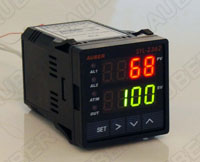Heya everyone,
Today I tested my HERMS PID system. I brought the temps of the HLT and BK up to around 60 degrees and turned off the BK elements. I then pretended the BK was the MT and recirculated it through the heat exchange coil in the HLT. The sensor is a Type J thermocouple in a home-built thermowell inside the Heat exchanger output.
Every 5 mins I measured the temperatures of the BK and HLT, and took the PID's reading and logged them.
The target (set) temp was 66 degrees.
The problem I found is that the PID stalled when it got to 67 degrees, and stayed there, while the HLT and BK temps dropped.
I had set the PID to 'autotune', which as I understands bypasses the P, I, and D settings.
There's one setting that I don't know what it is, it says '+5c' on the PID but seems to be some sort of temp correction. The temp always reads wrong unless I adjust it to the right temp via the '+5c' setting.
Any tips on whats wrong?
Cheers,
H
Here's the log
http://i48.tinypic.com/2r2qiyc.png
Today I tested my HERMS PID system. I brought the temps of the HLT and BK up to around 60 degrees and turned off the BK elements. I then pretended the BK was the MT and recirculated it through the heat exchange coil in the HLT. The sensor is a Type J thermocouple in a home-built thermowell inside the Heat exchanger output.
Every 5 mins I measured the temperatures of the BK and HLT, and took the PID's reading and logged them.
The target (set) temp was 66 degrees.
The problem I found is that the PID stalled when it got to 67 degrees, and stayed there, while the HLT and BK temps dropped.
I had set the PID to 'autotune', which as I understands bypasses the P, I, and D settings.
There's one setting that I don't know what it is, it says '+5c' on the PID but seems to be some sort of temp correction. The temp always reads wrong unless I adjust it to the right temp via the '+5c' setting.
Any tips on whats wrong?
Cheers,
H
Here's the log
http://i48.tinypic.com/2r2qiyc.png





